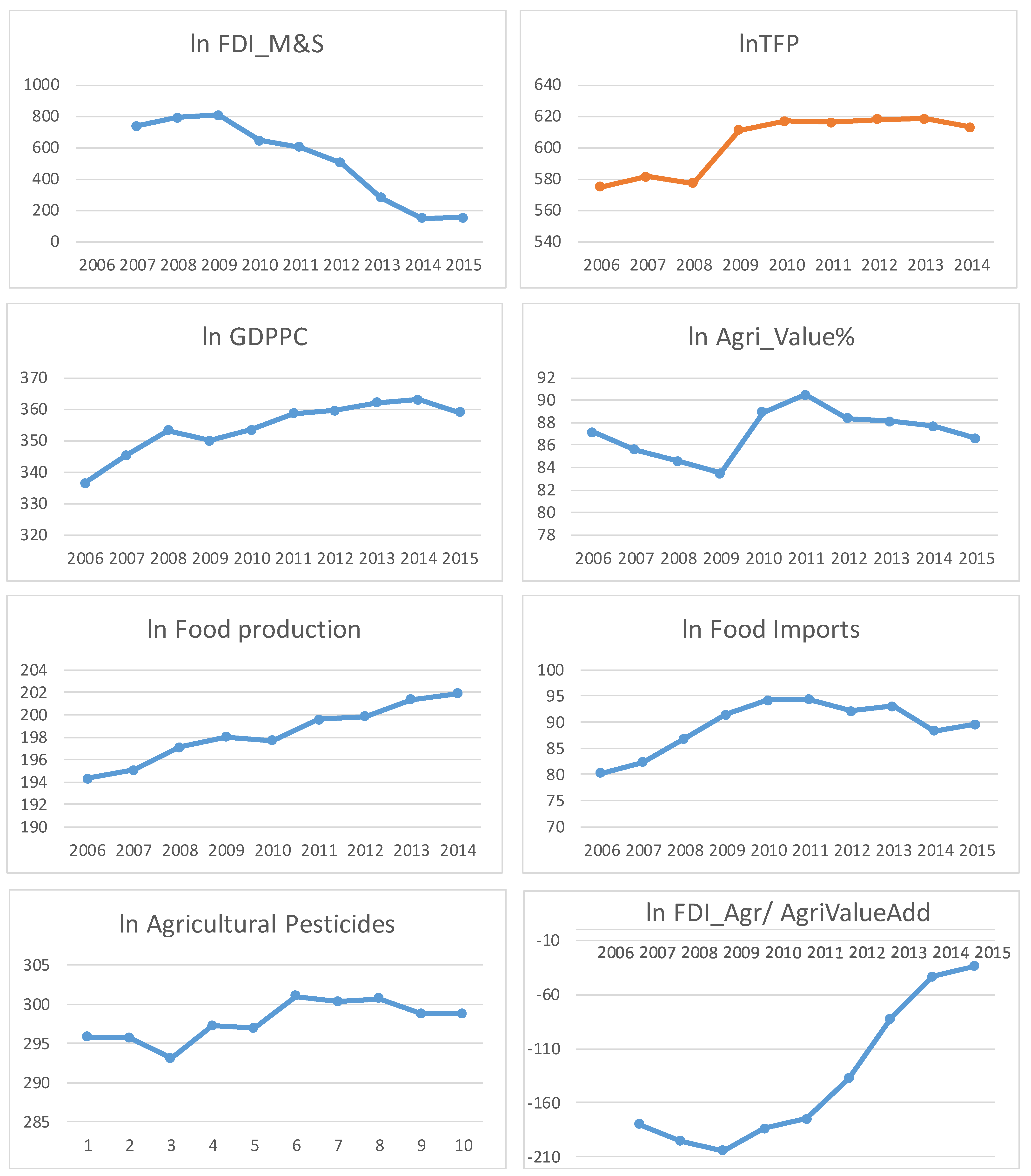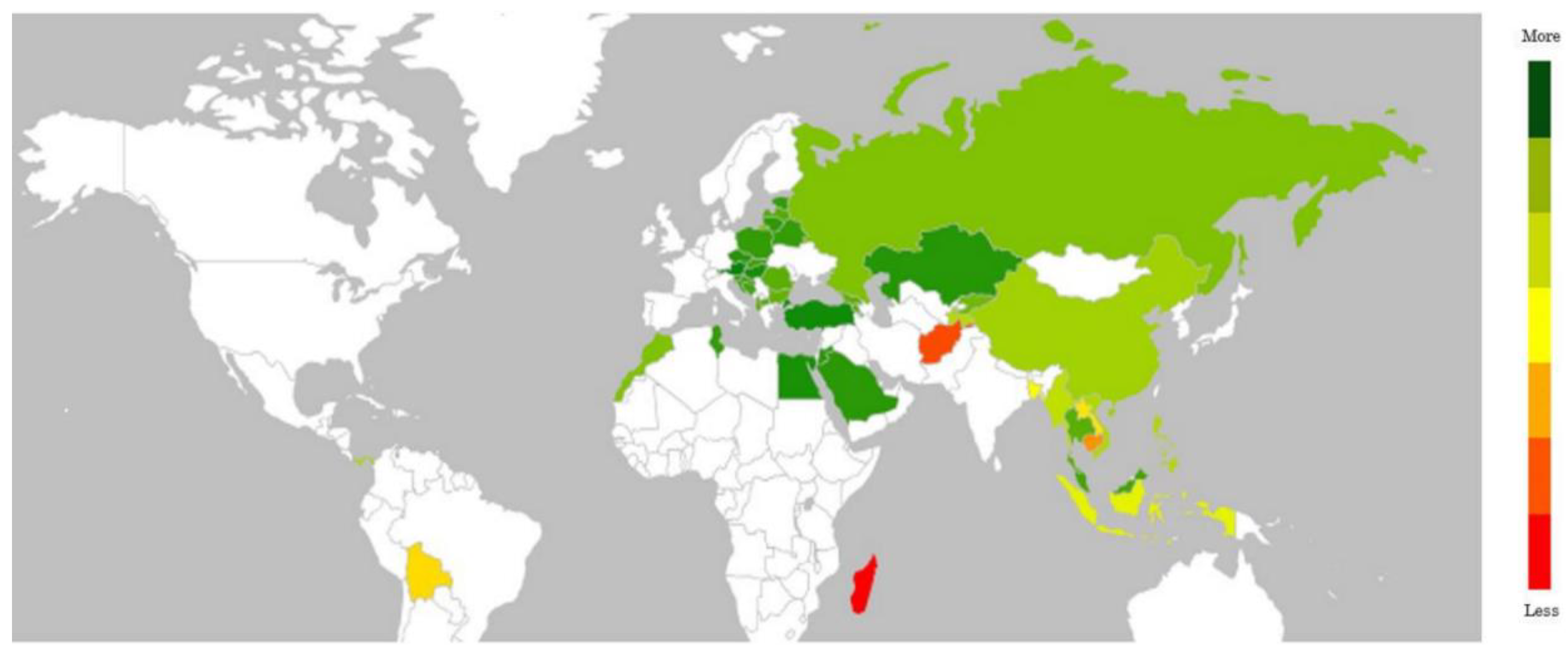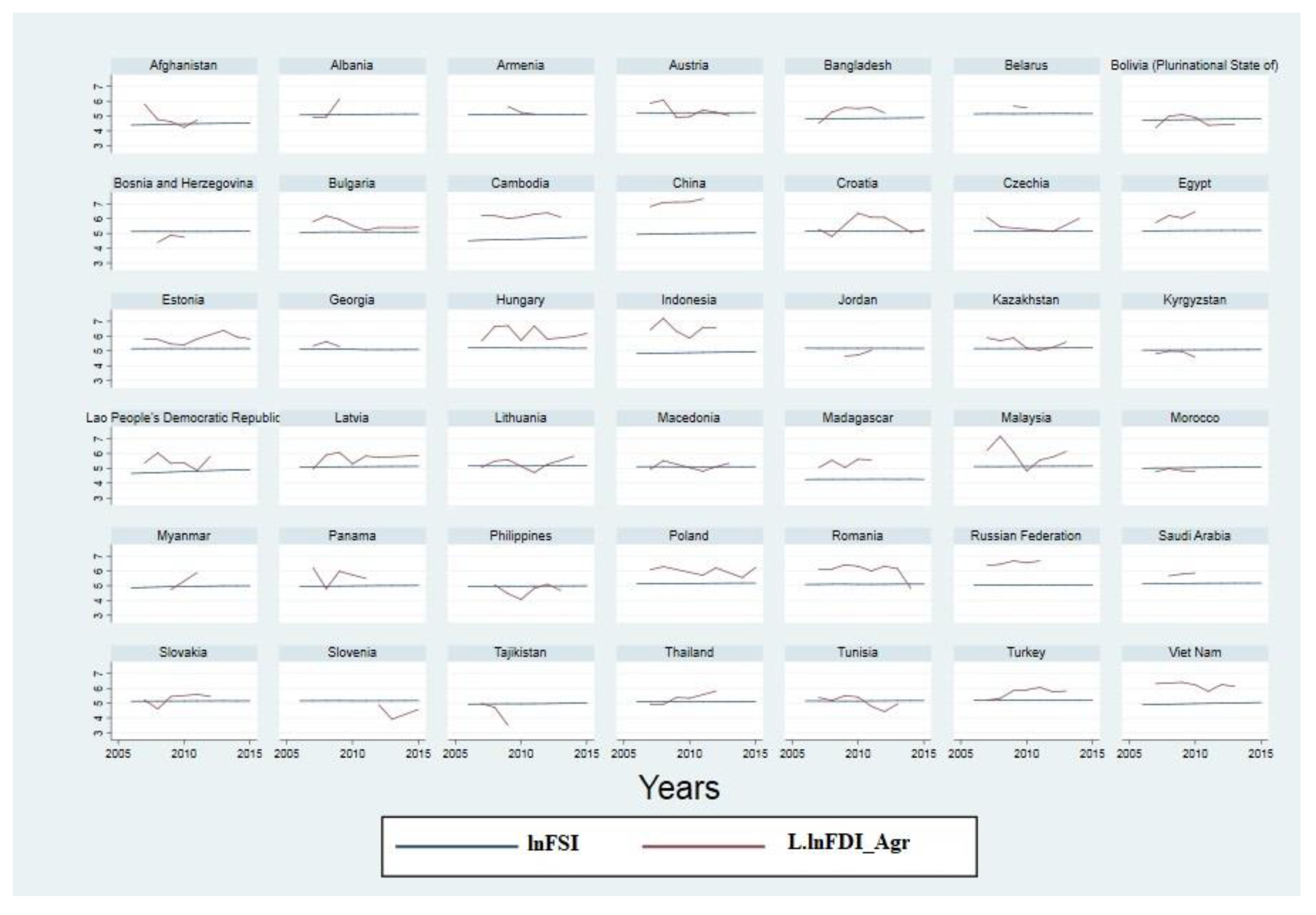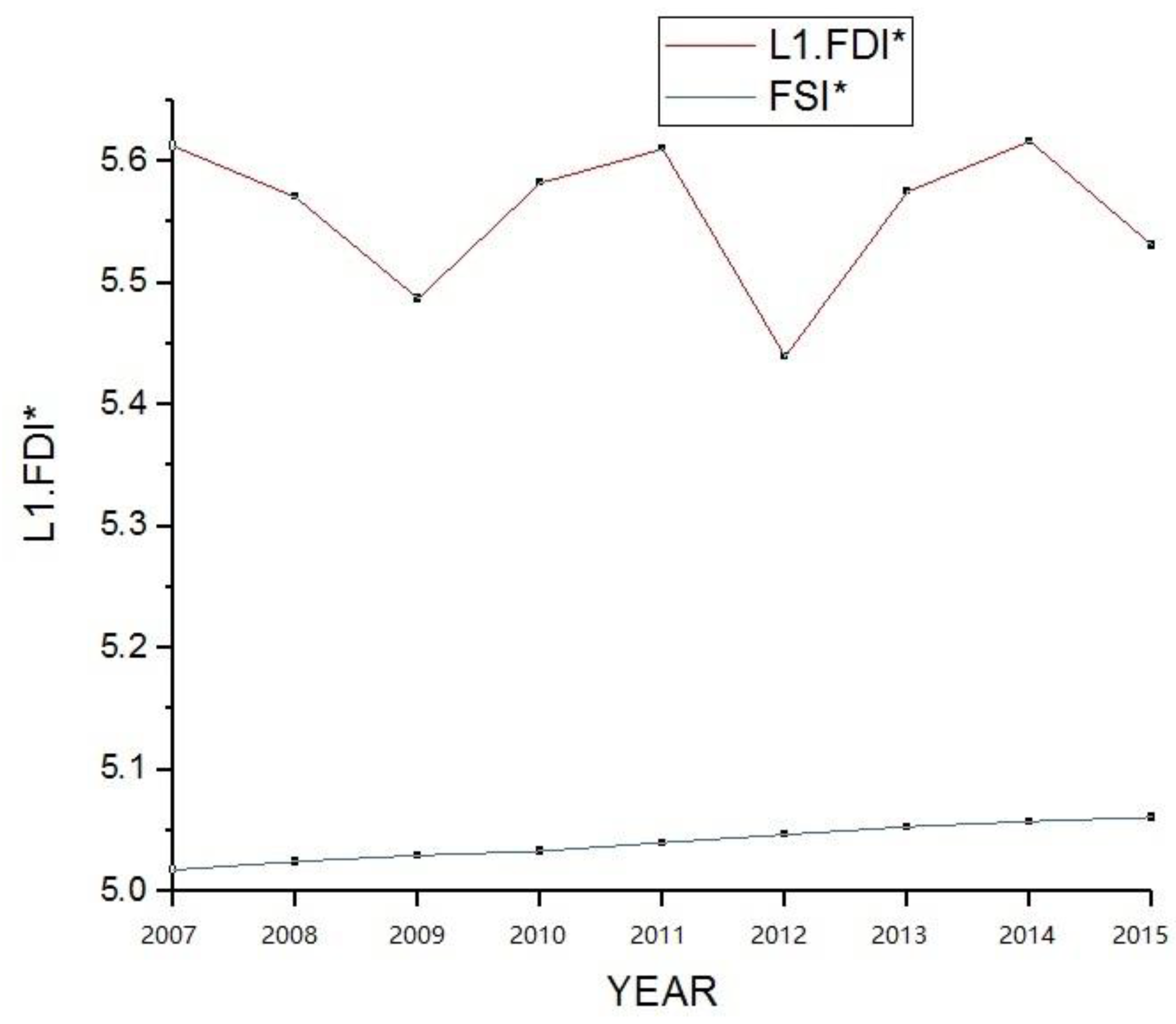Analyzing the Relationship between Agricultural FDI and Food Security: Evidence from Belt and Road Countries
Abstract
1. Introduction
2. Literature Review and Hypotheses Development
2.1. Food Security
2.2. Agricultural FDI and Food Security
2.3. Food Security and Agricultural Productivity
3. Data and Variables
4. Methodology
4.1. Principal Component Analysis (PCA)
4.2. The Direct Relationship
4.3. The Indirect Relationship (2SLS)
4.3.1. First Stage
4.3.2. Second Stage
5. Results and Discussion
5.1. Is There Any Difference in the Direction of the Relationship Between Agricultural FDI and Food Security among Countries?
5.2. Is There a Direct Relationship between Agricultural FDI and Food Security?
5.3. What is the Nature of the Relationship between Agricultural FDI and the Components of Food Security Index?
5.4. Is There an Indirect Relationship between Agricultural FDI and Food Security Through Agricultural Productivity?
5.5. Robustness Check
6. Conclusions
Author Contributions
Funding
Acknowledgments
Conflicts of Interest
Appendix A
| Variables | Definition | Source |
|---|---|---|
| Access to improved sanitation facilities | The percentage of the population with access to improved sanitation facilities. | FAOSTAT |
| Access to improved water sources | The percentage of the population with access to an improved water source. | |
| Dietary energy supply adequacy | The dietary energy supply as a percentage of the average dietary energy requirement in each country (3-year average). | |
| Per capita food production variability | The total value of annual food production variability, in International Dollars, divided by the total population (kcal/capita/day) (I$ per person constant 2004–06) (3-year average) | |
| FSI | The composite indicator of food security | Authors’ calculation |
| TFP | Total Factor Productivity | Authors’ calculation |
| FDI_Agr | FDI inflows to Agriculture Sector (value in millions US$) | FAOSTAT |
| FDI_M&S | FDI inflows to Manufacturing and Services sectors (value in millions US$) | FAOSTAT, World Bank |
| GDPPC | GDP per capita (current US$) | World Bank |
| Agri_Value% | Agriculture, value-added (% of GDP) | |
| AgriValueAdd | Agriculture, value-added (current US$) | |
| Food production | Food production index (2004–2006 = 100) | World Development Indicators |
| Food Imports | Food imports (% of merchandise imports) | |
| Agricultural Pesticides | Pesticides (total) tons of active ingredients | FAOSTAT |
| FDI_Agr/ AgriValueAdd | Dividing FDI_Agr on AgriValueAdd | Authors’ calculation |
| Capital | Net Capital Stocks (Agriculture, Forestry and Fishing) US$, 2005 prices | FAOSTAT |
| Labor | Labor force in agriculture, in thousand people | UNCTAD |
| (1) | (2) | (3) | (4) | (5) | |
|---|---|---|---|---|---|
| Variables | Obs. | Mean | Standard Deviation | Min | Max |
| Access to improved sanitation facilities | 420 | 81.54 | 20.89 | 10.90 | 100 |
| Access to improved water sources | 420 | 90.87 | 13.16 | 40.80 | 100 |
| Dietary energy supply adequacy | 420 | 122.2 | 14.52 | 90 | 158 |
| Per capita food production variability | 420 | 13.23 | 11.84 | 0.400 | 70.10 |
| FSI | 420 | 156.8 | 26.04 | 69.91 | 186.8 |
| TFP | 402 | 14.91 | 0.613 | 13.31 | 16.95 |
| FDI_Agr | 223 | 1.205e+08 | 3.905e+08 | 37,579 | 3.607e+09 |
| FDI_M&S | 223 | 1.071e+10 | 2.719e+10 | 3.239e+07 | 2.437e+11 |
| GDPPC | 420 | 8168 | 8872 | 272.6 | 51,733 |
| Agri_Value% | 420 | 11.35 | 9.375 | 0 | 43.92 |
| AgriValueAdd | 420 | 2.764e+10 | 1.066e+11 | 0 | 9.773e+11 |
| Food production | 420 | 102.2 | 37.50 | 0 | 182.7 |
| Food Imports | 420 | 9.907 | 5.020 | 0 | 23.72 |
| Agricultural Pesticides | 370 | 55,613 | 281,045 | 0.0700 | 1.816e+06 |
| FDI_Agr/ AgriValueAdd | 216 | 0.0132 | 0.0287 | 9.38e-06 | 0.244 |
| Capital | 410 | 26,680 | 79,362 | 92.84 | 757,190 |
| Labor | 420 | 1.533e+06 | 3.969e+06 | 0 | 3.261e+07 |
| Variable | (1) | (2) | (3) | (4) | (5) | (6) | (7) | (8) | (9) |
|---|---|---|---|---|---|---|---|---|---|
| (1) ln FSI | 1 | ||||||||
| (2) ln FDI_Agr | 0.13359(a) | 1 | |||||||
| (3) ln FDI_M&S | 0.22178(a) | 0.1982(a) | 1 | ||||||
| (4) ln FDI_Agr/ AgriValueAdd | 0.06686(a) | 0.8823(a) | 0.1215(a) | 1 | |||||
| (5) ln GDPPC | 0.55285(a) | 0.2301(a) | 0.1350(a) | 0.125(b) | 1 | ||||
| (6) ln Agri_Value% | −0.31661 | 0.054689 | −0.12978 | 0.04055 | −0.33421 | 1 | |||
| (7) lnFood production | 0.55580 | 0.058527 | 0.03404 | -0.0164 | 0.67817 | −0.05722 | 1 | ||
| (8) lnFood Imports | 0.19727(c) | −0.10492 | −0.2783 | −0.1335 | 0.2367(b) | −0.12236 | 0.1677 | 1 | |
| (9) ln Agricultural Pesticides | 0.31957(b) | 0.1403(b) | 0.2042(b) | 0.117(b) | 0.2632(b) | −0.1056(b) | 0.2604 | −0.0283(b) | 1 |
| (10) lnTFP | 0.38895(a) | 0.2962(a) | 0.2083(a) | 0.182(a) | 0.8163(a) | 0.0664(b) | 0.6290 | −0.0283(b) | 0.259(a) |
| Variables | FSI |
|---|---|
| lnTFP | 0.0693*** |
| (0.0164) | |
| L. lnFDI_M&S | −0.00129 |
| (0.00108) | |
| lnAgri_Value% | −0.0469*** |
| (0.00844) | |
| lnFood production | 0.0496*** |
| (0.0107) | |
| lnFood Imports | −0.00775 |
| (0.00617) | |
| Residuals | −0.0424** |
| (0.0182) | |
| Constant | 3.935*** |
| (0.221) | |
| Observations | 163 |
| Number of id | 35 |
| R-squared | 0.514 |
| R2 Overall | 0.257 |
| Variable | Value |
|---|---|
| lnFSI | 155.5561*** |
| lnTFP | 281.3883*** |
| L. lnFDI_Agr | 212.9275*** |
| L. lnFDI_M&S | 243.0045*** |
| L. ln FDI_Agr/ AgriValueAdd | 162.0508*** |
| lnAgri_Value% | 118.7566*** |
| lnGDPPC | 357.5086*** |
| lnFood production | 133.6557*** |
| lnFood Imports | 171.2784*** |
| ln Agricultural Pesticides | 339.7884 *** |
| We report inverse chi-squared of Fisher’s unit-root test. | |
| ID | Country | ID | Country | ID | Country |
|---|---|---|---|---|---|
| 1 | Afghanistan | 15 | Estonia | 29 | Panama |
| 2 | Albania | 16 | Georgia | 30 | Philippines |
| 3 | Armenia | 17 | Hungary | 31 | Poland |
| 4 | Austria | 18 | Indonesia | 32 | Romania |
| 5 | Bangladesh | 19 | Jordan | 33 | Russian |
| 6 | Belarus | 20 | Kazakhstan | 34 | Saudi Arabia |
| 7 | Bolivia | 21 | Kyrgyzstan | 35 | Slovakia |
| 8 | Bosnia and Herzegovina | 22 | Laos | 36 | Slovenia |
| 9 | Bulgaria | 23 | Latvia | 37 | Tajikistan |
| 10 | Cambodia | 24 | Lithuania | 38 | Thailand |
| 11 | China | 25 | Madagascar | 39 | Macedonia |
| 12 | Croatia | 26 | Malaysia | 40 | Tunisia |
| 13 | Czech Republic | 27 | Morocco | 41 | Turkey |
| 14 | Egypt | 28 | Myanmar | 42 | Vietnam |

References
- Assembly, U.G. Transforming Our World: The 2030 Agenda for Sustainable Development; United Nations: New York, NY, USA, 2015.
- Boamah, J.; Appiah-Kubi, M. One belt one road: Capital investments, economic integration, and growth of participating countries. In Foreign Business in China and Opportunities for Technological Innovation and Sustainable Economics; IGI Global: Hershey, PA, USA, 2019; pp. 28–43. [Google Scholar] [CrossRef]
- Yang, Z.; Zeng, X. Envisioning the impact of the belt and road initiative on regional labor markets. Sustainability 2019, 11, 2189. [Google Scholar] [CrossRef]
- Chen, Y.; Fan, Z.; Zhang, J.; Mo, M. Does the connectivity of the belt and road initiative contribute to the economic growth of the belt and road countries? Emerg. Mark. Financ. Trade 2019, 55, 3227–3240. [Google Scholar] [CrossRef]
- Wang, Y.; Xie, L.; Zhang, Y.; Wang, C.; Yu, K. Does FDI promote or inhibit the high-quality development of agriculture in China? An agricultural GTFP perspective. Sustainability 2019, 11, 4620. [Google Scholar] [CrossRef]
- Gherghina, Ș.C.; Simionescu, L.N.; Hudea, O.S. Exploring foreign direct investment–economic growth nexus—Empirical evidence from central and eastern European countries. Sustainability 2019, 11, 5421. [Google Scholar] [CrossRef]
- Ahmad, F.; Umar Draz, M.; Su, L.; Ozturk, I.; Rauf, A.; Ali, S. Impact of FDI inflows on poverty reduction in the ASEAN and SAARC economies. Sustainability 2019, 11, 2565. [Google Scholar] [CrossRef]
- Chen, M.X.; Lin, C. Foreign Investment across the Belt and Road: Patterns, Determinants, and Effects; The World Bank: Washington, DC, USA, 2018. [Google Scholar]
- Shaofeng, C.; Yang, L.; Liyang, S. Sustainable agriculture in the “Belt and Road” region in conjunction with the Sustainable Development Goals. J. Resour. Ecol. 2019, 10, 649–656. [Google Scholar] [CrossRef]
- Costa, L.V.; Gomes, M.F.M.; de Lelis, D.A.S. Food security and agricultural productivity in Brazilian metropolitan regions. Procedia Econ. Financ. 2013, 5, 202–211. [Google Scholar] [CrossRef]
- Ogundari, K. The paradigm of agricultural efficiency and its implication on food security in Africa: what does meta-analysis reveal? World Dev. 2014, 64, 690–702. [Google Scholar] [CrossRef]
- Brummer, B. Food policy to alleviate rural poverty: The potential contribution of productivity growth in agriculture and agricultural trade liberalization. Q J. Int. Agric. 2006, 45, 1–6. [Google Scholar]
- Ben Slimane, M.; Huchet-Bourdon, M.; Zitouna, H. The role of sectoral FDI in promoting agricultural production and improving food security. Int. Econ. 2016, 145, 50–65. [Google Scholar] [CrossRef]
- Liu, P. Impacts of Foreign Agricultural Investment on Developing Countries: Evidence from Case Studies; FAO Commodity Trade Policy Research Working Papers: Rome, Italy, 2014. [Google Scholar]
- Ogalo, V. Foreign Investment in Agriculture in Eastern Africa, a General Overview of Trends and Issues; Friedrich Ebert Stiftung-Kenya: Nairobi, Kenya, 2011. [Google Scholar]
- Rakotoarisoa, M.A. A Contribution to the Analyses of the Effects of Foreign Agricultural Investment on the Food Sector and Trade in Sub-Saharan Africa; FAO: Rome, Italy, 2011. [Google Scholar]
- Wieck, C.; Rudloff, B.; Heucher, A. Agri-Investments and Public Spending in Selected Vulnerable Countries–Will They Contribute to Reduce Food insecurity? University of Bonn: Bonn, Germany, 2014. [Google Scholar]
- Mihalache-O’keef, A.; Li, Q. Modernization vs. dependency revisited: Effects of foreign direct investment on food security in less developed countries1. Int. Stud. Q. 2011, 55, 71–93. [Google Scholar] [CrossRef]
- Djokoto, J.G. Effects of foreign direct investment inflows into agriculture on food security in Ghana. J. Econ. Sustain. Dev. 2012, 3, 81–92. [Google Scholar]
- FAO. Rome Declaration on World Food Security and World Food Summit Plan of Action: World Food Summit 13–17 November 1996; FAO: Rome, Italy, 1996. [Google Scholar]
- FAO. Food Security. Policy Brief; FAO: Rome, Italy, 2006. [Google Scholar]
- Yaro, J.A. Theorizing food insecurity: Building a livelihood vulnerability framework for researching food insecurity. Norsk Geogr. Tidsskr. Nor. J. Geogr. 2004, 58, 23–37. [Google Scholar] [CrossRef]
- Carolan, M.S. Reclaiming Food Security; Routledge: London, UK, 2013. [Google Scholar]
- Vivero Pol, J.L. Food as a commons: Reframing the narrative of the food system. SSRN Electron. J. 2013. [Google Scholar] [CrossRef]
- Dunning, J.H. International Production and the Multinational Enterprise (RLE International Business); Routledge: London, UK, 2013. [Google Scholar]
- Louis, T. Third World Multinationals: The Rise of Foreign Investment from Developing Countries; The MIT Press: Cambridge, MA, USA, 1983. [Google Scholar]
- Lall, S.; Mohammad, S. Multinationals in Indian big business: Industrial characteristic of foreign investment in a heavily regulated economy. J. Dev. Econ. 1983, 13, 143–157. [Google Scholar] [CrossRef]
- Petit, M.L.; Sanna-Randaccio, F. Technological innovation and multinational expansion: A two-way link? J. Econ. 1998, 68, 1–26. [Google Scholar] [CrossRef]
- Jiang, X.; Chen, Y.; Wang, L. Can China’s agricultural FDI in developing countries achieve a win-win goal?—Enlightenment from the literature. Sustainability 2019, 11, 41. [Google Scholar] [CrossRef]
- Chaudhuri, S.; Banerjee, D. FDI in agricultural land, welfare and unemployment in a developing economy. Res. Econ. 2010, 64, 229–239. [Google Scholar] [CrossRef]
- UN. World Investment Report 2017: Investment and the Digital Economy; United Nations Conference on Trade Development: New York, NY, USA; Geneva, Switzerland, 2017. [Google Scholar]
- Lowder, S.K.; Carisma, B. Financial Resource Flows to Agriculture; A Review of Data on Government Spending, Official Development Assistance and Foreign Direct Investment; FAO: Rome, Italy, 2011; p. 44. [Google Scholar]
- Mergos, G.; Papanastassiou, M. Food Security and Sustainability; Springer: Berlin, Germany, 2017. [Google Scholar]
- Hausman, J.A. Specification tests in econometrics. Econom. J. Econom. Soc. 1978, 46, 1251–1271. [Google Scholar] [CrossRef]
- Abdi, H.; Williams, L.J. Principal component analysis. Wiley Interdiscip. Rev. Comput. Stat. 2010, 2, 433–459. [Google Scholar] [CrossRef]
- Davidson, R.; MacKinnon, J.G. Estimation and Inference in Econometrics; OUP Catalogue: Oxford, UK, 1993. [Google Scholar]
- Coma, C.W.; Douglas, P.H. A Theory of Production; American Economic Association: Nashville, TN, USA, 1928. [Google Scholar]
- Tuan, C.; Ng, L.F.Y.; Zhao, B. China’s post-economic reform growth: The role of FDI and productivity progress. J. Asian Econ. 2009, 20, 280–293. [Google Scholar] [CrossRef]
- O’Toole, C.M.; Newman, C.; Hennessy, T. Financing constraints and agricultural investment: Effects of the Irish financial crisis. J. Agric. Econ. 2014, 65, 152–176. [Google Scholar] [CrossRef]
- Suleman, A. Fostering FDI in the Agriculture Sector. The Pakistan Development Review; Pakistan Institute of Development Economics: Islamabad, Pakistan, 2009; pp. 821–838. [Google Scholar]
- FAO. New Approaches to the Measurement of Food Security. 2013; Available online: http://www.fao.org/ (accessed on 25 February 2020).



| Component | Eigenvalue | % of Variance | Cumulative % |
|---|---|---|---|
| 1 | 678.184 | 70.615 | 70.615 |
| 2 | 126.302 | 13.151 | 83.767 |
| 3 | 118.312 | 12.319 | 96.086 |
| 4 | 37.592 | 3.914 | 100 |
| Variables | Eigenvalue | Component | Coefficient |
|---|---|---|---|
| X1 | 678.184 | 20.073 | 0.770794 |
| X2 | 678.184 | 11.964 | 0.459412 |
| X3 | 678.184 | 10.665 | 0.409531 |
| X4 | 678.184 | 4.284 | 0.164504 |
| (1) | (2) | (3) | |
|---|---|---|---|
| Variables | Fixed Effect | Fixed Effect | Fixed Effect |
| L. lnFDI_Agr | −0.00169* | −0.00117 | 0.0131** |
| (0.000958) | (0.000760) | (0.00624) | |
| L. lnFDI_M&S | 0.00410** | 0.00261** | 0.00125 |
| (0.00166) | (0.00132) | (0.00135) | |
| L. lnFDI_Agr/ AgriValueAdd | −0.0144** | ||
| (0.00635) | |||
| lnGDPPC | 0.0635*** | 0.0457*** | |
| (0.00656) | (0.00824) | ||
| lnFood Production | 0.119*** | 0.0533*** | 0.0486*** |
| (0.0129) | (0.0123) | (0.0122) | |
| lnFood Imports | 0.000890 | 0.00741 | −0.00275 |
| (0.00855) | (0.00680) | (0.00740) | |
| Constant | 4.407*** | 4.187*** | 4.094*** |
| (0.0700) | (0.0599) | (0.0998) | |
| Observations | 200 | 200 | 193 |
| R-squared | 0.382 | 0.616 | 0.560 |
| Number of id | 41 | 41 | 41 |
| R2 overall | 0.0296 | 0.617 | 0.539 |
| (1) | (2) | (3) | (4) | |
|---|---|---|---|---|
| Variables | Fixed Effect (Access to Facilities) | Fixed Effect (Access to Water) | Fixed Effect (Energy Supply) | Fixed Effect (Food Production Variability) |
| L. lnFDI_Agr | 0.0441*** | 0.0291*** | −0.00435 | −0.481** |
| (0.0125) | (0.00957) | (0.00653) | (0.223) | |
| L. lnFDI_M&S | 0.00116 | 0.000434 | 0.000328 | 0.0420 |
| (0.00271) | (0.00207) | (0.00141) | (0.0482) | |
| L. lnFDI_Agr/ AgriValueAdd | −0.0456*** | −0.0301*** | 0.00264 | 0.465** |
| (0.0127) | (0.00973) | (0.00664) | (0.227) | |
| lnGDPPC | 0.0280* | 0.0201 | 0.0436*** | 0.988*** |
| (0.0165) | (0.0126) | (0.00861) | (0.294) | |
| lnFood production | 0.110*** | 0.0804*** | 0.00784 | −0.540 |
| (0.0244) | (0.0187) | (0.0127) | (0.435) | |
| lnFood Imports | −0.0319** | −0.0144 | 0.0134* | 0.266 |
| (0.0148) | (0.0113) | (0.00774) | (0.264) | |
| Constant | 2.613*** | 3.315*** | 4.448*** | 5.625 |
| (0.200) | (0.153) | (0.104) | (3.567) | |
| Observations | 193 | 193 | 193 | 193 |
| R-squared | 0.447 | 0.402 | 0.290 | 0.080 |
| Number of id | 41 | 41 | 41 | 41 |
| R2 overall | 0.0839 | 0.130 | 0.354 | 0.209 |
| (1) First Stage | (2) Second Stage | |
|---|---|---|
| Variables | Fixed Effect(lnTFP) | Fixed Effect(lnFSI) |
| lnTFP_hat | 0.0850*** | |
| (0.0166) | ||
| L. lnFDI_Agr | 0.278*** | |
| (0.0611) | ||
| L. lnFDI_M&S | −0.00162 | |
| (0.00115) | ||
| L. lnFDI_Agr/ AgriValueAdd | −0.078*** | |
| (0.0625) | ||
| lnAgri_Value% | −0.0334*** | |
| (0.00765) | ||
| lnFood production | 0.0527*** | |
| (0.0108) | ||
| lnFood Imports | −0.0149** | |
| (0.00621) | ||
| lnAgricultural Pesticides | 0.0184 | |
| (0.0223) | ||
| Constant | 8.490*** | 3.686*** |
| (1.337) | (0.224) | |
| Observations | 182 | 170 |
| R-squared | 0.150 | 0.468 |
| Number of id | 36 | 36 |
| R2 Overall | 0.284 | 0.133 |
| (1) | (2) | (3) | |
|---|---|---|---|
| Variables | Direct Effects | First Stage | Second Stage |
| L.lnFSI | 0.904*** | 0.894*** | |
| (0.0325) | (0.105) | ||
| L.lnFDI_Agr | 0.000194 | 0.183 | |
| (0.00154) | (0.149) | ||
| L.lnFDI_M&S | 0.000948 | −0.00106 | |
| (0.00154) | (0.00230) | ||
| L.lnFDI_Agr/ AgriValueAdd | −0.000865 | −0.165 | |
| (0.00149) | (0.138) | ||
| lnGDPPC | 0.00930* | ||
| (0.00542) | |||
| lnFood production | 0.0119 | 0.000294 | |
| (0.00877) | (0.0120) | ||
| lnFood Imports | −0.000202 | −0.00946 | |
| (0.00616) | (0.0114) | ||
| L.lnTFP | 0.461 | ||
| (0.348) | |||
| lnAgricultural Pesticides | −0.0466 | ||
| (0.0585) | |||
| lnTFP_hat | 0.00844 | ||
| (0.0144) | |||
| lnagrivadpercent | −0.0118 | ||
| (0.0182) | |||
| Constant | 0.219 | 16.23 | −0.639 |
| (1.021) | (30.94) | (1.127) | |
| year | YES | YES | YES |
| F | 1000.13*** | 19.78*** | 814.71*** |
| Instruments | 38 | 14 | 22 |
| AR(1) | −2.48(0.013) | −2.26(0.024) | −2.05(0.041) |
| AR(2) | −1.56(0.119) | −1.92(0.054) | −0.69(0.492) |
| Hansen-J | 27.61(0.539) | 22.66(0.004) | 12.76(0.545) |
| Observations | 193 | 182 | 163 |
| Number of id | 41 | 36 | 35 |
© 2020 by the authors. Licensee MDPI, Basel, Switzerland. This article is an open access article distributed under the terms and conditions of the Creative Commons Attribution (CC BY) license (http://creativecommons.org/licenses/by/4.0/).
Share and Cite
Yao, H.; Alhussam, M.I.; Abu Risha, O.; Memon, B.A. Analyzing the Relationship between Agricultural FDI and Food Security: Evidence from Belt and Road Countries. Sustainability 2020, 12, 2906. https://doi.org/10.3390/su12072906
Yao H, Alhussam MI, Abu Risha O, Memon BA. Analyzing the Relationship between Agricultural FDI and Food Security: Evidence from Belt and Road Countries. Sustainability. 2020; 12(7):2906. https://doi.org/10.3390/su12072906
Chicago/Turabian StyleYao, Hongxing, Mohammed Ismail Alhussam, Omar Abu Risha, and Bilal Ahmed Memon. 2020. "Analyzing the Relationship between Agricultural FDI and Food Security: Evidence from Belt and Road Countries" Sustainability 12, no. 7: 2906. https://doi.org/10.3390/su12072906
APA StyleYao, H., Alhussam, M. I., Abu Risha, O., & Memon, B. A. (2020). Analyzing the Relationship between Agricultural FDI and Food Security: Evidence from Belt and Road Countries. Sustainability, 12(7), 2906. https://doi.org/10.3390/su12072906





